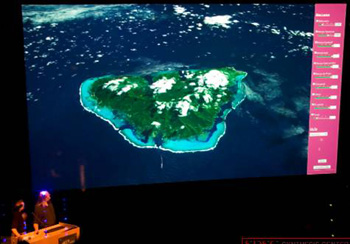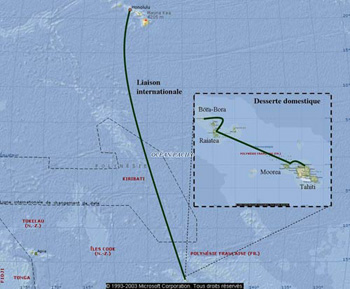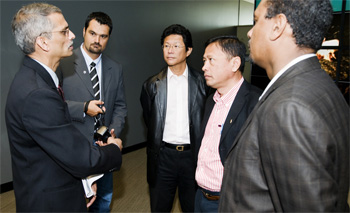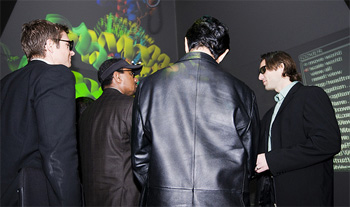|
"We are currently using satellite for bandwidth that is limited to 30 megabits per second, so we decided to invest in optical fiber that is very expensive," said Georges Puchon, Minister of Finance and Digital Economy for the French overseas territory that is mostly autonomous, while still part of the French Republic. "We are deploying nearly 5,000 kilometers of cable and will have a direct link to the United States, so now we have to make sure that we maximize the benefits of the new bandwidth for our 250,000 citizens."
Puchon was part of a delegation of French Polynesian officials, including Minister of Education and Research Tearii Alpha, Information and Communications Technology Advisor Karl Tefaatau, and business leader Gilbert Wane. The delegates visited UC Berkeley prior to arriving at Calit2, and they were joined by Neil Davies, who directs UC Berkeley's Gump South Pacific Research Station in Moorea. The Gump Station is home to the only coral reef Long-Term Ecological Research (LTER) site funded by the U.S. National Science Foundation (NSF), and involves researchers from several UC campuses. Moorea is also one of only four key sites in the international Coral Reef Environmental Observatory Network (CREON).
|
"This is the first delegation from French Polynesia at ministerial level to visit the Berkeley and San Diego campuses since the establishment of the Gump Station in 1985, so it's an historic occasion," observed Davies about the Nov. 21-25 visit. "The delegation outlined needs and opportunities in French Polynesia on one side, and heard about the research capacity and interests of the University of California on the other. The goal: to identify potential areas of collaboration and to initiate ideas for joint research programs."
The San Diego itinerary stemmed, in part, from previous contacts established by Calit2 Director Larry Smarr. Smarr currently sits on the UC Gump Station's advisory board. In 2007, at the invitation of the UC Santa Barbara faculty who are the PIs on the NSF Moorea Coral Reef LTER, Smarr spent time at the Gump Station to study how best to bring high performance cyberinfrastructure to the station, notably in support of efforts at saving Moorea's coral reefs.
"The French Polynesian plan is truly visionary," said Smarr, who is also a professor of computer science in UC San Diego's Jacobs School of Engineering. "Moorea is the only place in the world where the whole ecosystem will be DNA coded [thanks to the Moorea Biocode Project funded by the Gordon and Betty Moore Foundation]. Scientists around the world will need to work with these data sets and collaborate with partners in Moorea, and this wouldn't be possible without the investment in transoceanic fiber bandwidth."
Calit2 is also involved in discussions on the Digital Moorea project, in which several UC campuses and MIT are exploring new approaches to the digital surveillance of marine ecosystems, including deployment of sensor networks and robots to monitor coral reefs.
|
The French Polynesian officials expressed interest in what types of facilities or services they could provide that would be attractive to California companies or research institutions, which might be attracted to Moorea as a destination for research, classes, retreats, sabbaticals, conferences, or for 'scientific tourism'. Prior to visiting Calit2, the ministers met with officials at the Corporation for Education Network Initiatives in California (CENIC). They emerged from that meeting and said they are now considering setting up a similar entity in French Polynesia to promote the use of their newfound bandwidth in the education and research sectors.
France, through the Office des Postes et Télécommunications (OPT) - the island's principal telecom provider - is effectively funding the aggressive push to connect French Polynesia with research centers around the world. In January 2008, OPT signed a deal with Alcatel-Lucent Submarine Network (ASN) for the latter to lay 4,650 kilometers of undersea optical fiber between Tahiti and Hawaii. The link to Hawaii will provide French Polynesia with an on-ramp to high-speed U.S. commercial and research networks, as well as undersea cables to key Asian countries.
|
In addition, ASN is laying 305 kilometers of cable linking Tahiti and the rest of the Society Islands, one of five archipelagos that constitute French Polynesia.
"Fiber optic cable will not only link Tahiti to Hawaii, but will also connect populations on all of the Society Islands - six islands from Tahiti to Bora Bora - which account for the vast majority of the French Polynesian population," said Gump Station director Davies. "This presents a remarkable opportunity to make French Polynesia one of the most digitally enabled societies in the world."
The Honotua optical fiber network is scheduled to be completed in April 2010, at a cost of 72 million euros (nearly US$95 million at the current exchange rate). While the cable currently being laid has a maximum capacity of 32 10Gbps lines, the initial capacity will consist of two 10Gbps wavelengths. (According to the Gump Station's Davies, the research field station today can only count on satellite-based ADSL connectivity at 512 kilobits per second.)
|
At Calit2, the French Polynesian officials said the government is now committed to doubling the maximum capacity to 64 10Gbps, and pointed to a report on areas that could be enabled by the new bandwidth, including life sciences, renewable energy, and data centers. In Atkinson Hall, the visitors were treated to a series of technology demonstrations to highlight the need for visualizing science. The demos included ultra-high-definition, live streaming video on Calit2's 4K system (four times the resolution of high-definition TV); 3D immersive in the StarCAVE virtual-reality environment; the Varrier autostereoscopic (3D without glasses) tiled display; and the HIPerSpace system, one of the highest-resolution display systems in the world, at 286 million pixels.
In his remarks, the Finance Minister also indicated that French Polynesia won't stop building out its IT infrastructure. It has already held talks on extending the optical-fiber network from Tahiti to New Caledonia, where it would intersect with existing fiber to Sydney, Australia. The government has also held talks with Chile about a direct link from Tahiti - a link that could eventually make Tahiti a crucial link in the trans-Pacific communications chain. "We may eventually serve communications between South America and China," said Puchon.
Recently returned from a three-week stay in Australia [see Related Link below], Calit2 Director Larry Smarr is convinced that French Polynesia can become a hub for connectivity in the region. "I think you'll find lots of support in Australia," Smarr told the delegates. "You are on the front lines of global environmental challenges such as global warming and sea-level rise, so connectivity means French Polynesia can be a living laboratory for scientists around the world to study the adaptation of coral reefs to greatly increased stress."












1 comment:
You might be eligible for a new solar rebate program.
Click here and find out if you are qualified now!
Post a Comment